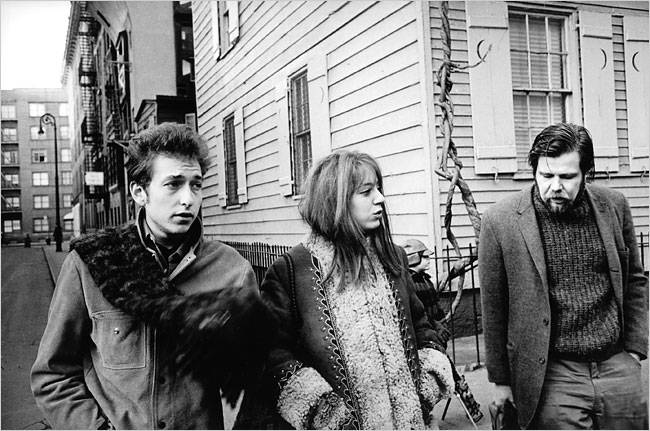Village People and Bronx Tales
LatentStyleCount="267">
A Freewheelin’ Time: A Memoir of Greenwich Village in the Sixties
Suze Rotolo
Broadway Books
Twisted Head
Carl Capotorto
Broadway Books
Two notable Italian American memoirs were published in 2008, Suze Rotolo’s A Freewheelin’ Time: A Memoir of Greenwich Village in the Sixties, and Carl Capotorto’s Twisted Head.
Rotolo, a veteran of Greenwich Village’s Sixties bohemia, is an artist and writer who’s best known for having been the consort of the decade’s leading culture hero, Bob Dylan. Carl Capotorto is an actor -- he played “Little Paulie” on The Sopranos and has appeared in independent films -- and writer who grew up in the Bronx during the 60s and 70s, in a household dominated by a tyrannical father. Ethnicity figures strongly in both memoirs, but these Italian American stories are set in a wider world of cultural, political, and social change.
Suze Rotolo’s book, not surprisingly, has attracted more attention; it was reviewed in the New York Times and Rotolo was the subject of a feature article in the paper by the pop music journalist Anthony De Curtis. The Times’ reviewer Sia Michel complained that Rotolo’s book didn’t “expand Dylanology.” I guess Michel was disappointed that Rotolo didn’t make her years with Him the entire focus of her book. She actually talks about her life before she, at 17, met the self-mythologizing ragamuffin from Hibbing, Minnesota, and relates some of her experiences after they broke up.
Rotolo doesn’t deny the enduring importance of that long-ago liaison. She writes, “In so many ways, my past with Bob Dylan has always been a presence, a parallel life alongside my own, no matter where I am, who I am with, or what I am doing.”
 But her story is fascinating on its own, as an Italian American life whose particulars often don’t conform to the familiar ethnic mythology. (For one thing, Roman Catholicism was unwelcome in the Rotolo home, given her parents’ atheism.) She was born in Queens in 1943, the second daughter of working class parents who had joined the Communist Party in the 1930s. Her Sicilian-born father, Gioacchino “Pete” Rotolo, and her mother, Mary Pezzati, the daughter of northern Italian immigrants, never had enough money. Pete, a union organizer and frustrated artist, was frequently out of work. Mary, an editor and columnist with the Italian Communist newspaper L’Unità, supplemented her meager earnings with various other jobs. At times they were so penurious that they sent their daughters to live with other, better-off relatives.
But her story is fascinating on its own, as an Italian American life whose particulars often don’t conform to the familiar ethnic mythology. (For one thing, Roman Catholicism was unwelcome in the Rotolo home, given her parents’ atheism.) She was born in Queens in 1943, the second daughter of working class parents who had joined the Communist Party in the 1930s. Her Sicilian-born father, Gioacchino “Pete” Rotolo, and her mother, Mary Pezzati, the daughter of northern Italian immigrants, never had enough money. Pete, a union organizer and frustrated artist, was frequently out of work. Mary, an editor and columnist with the Italian Communist newspaper L’Unità, supplemented her meager earnings with various other jobs. At times they were so penurious that they sent their daughters to live with other, better-off relatives.
Being a “red diaper baby” in the 1950s meant that Rotolo’s childhood was haunted by McCarthyism. She describes the pervasive secrecy and justified paranoia among the working class radicals she knew. When she saw newspaper photographs of the sons of Julius and Ethel Rosenberg, she was terrified that her own parents would end up in the electric chair.
Rotolo honors her parents’ politics; they were, she says, “humanist” Marxists, not dogmatic Stalinists. She describes her own radicalism as non-ideological, concerned mostly with peace, racial equality, and artistic freedom. The teenage Suze campaigns for nuclear disarmament (she meets Eleanor Roosevelt at an anti-nuclear rally) and civil rights (she works for Bayard Rustin and the Congress of Racial Equality). She has a knack for being ahead of the curve, whether she’s living in Italy in 1962, long before most Italian Americans went to la madrepatria to discover their roots, or discovering the nascent Greenwich Village folk music scene.
And years before the late-60s “second wave” of feminism, Rotolo had a feminist’s understanding of and hatred for sexism, which, as she recounts, flourished among the otherwise progressive artists and activists she knew.
She reminds us that Greenwich Village during the early 1960s was a largely Italian neighborhood, a place where first and second generation Italian Americans co-existed, if at times uneasily, with the young bohemians. One particular Italian, Mike Porco, turned a former working class bar into Gerde’s Folk City, the leading folk music venue where Dylan played his first New York gigs.
Rotolo, with economy of language and unerring insight, creates well-observed portraits of the Village scene and its leading characters, including the folk singer Dave Van Ronk and his wife Terrie Thal, Ramblin’ Jack Elliott, Odetta, Phil Ochs, and of course, Dylan, the man she loved but, because of his elusiveness, never fully trusted. Sia Michel’s comment notwithstanding, Rotolo does contribute to “Dylanology” through her account of their time together and her savvy assessments of his character and talent. She tells how she discovered that his real name was Robert Allen Zimmerman, and I won’t spoil the story for readers by repeating it here.
It’d be hard to improve on the way she sizes up this towering figure of American culture: “Bob always did as he saw fit. He was rarely swayed by outside demands or requests. He went where he wanted to go, even if it meant alienating his public, fans, friends, and lovers. He did not make anything easy for anyone, or for himself.”
 Twisted Head, the title of Carl Capotorto’s candid, brave, and often hilarious memoir, is the English translation of his surname. But “capo” means “head” in the sense of a boss, not a body part. The titular twisted head is the author’s father Philip, a Bronx padre padrone, domineering and obsessive to the point of madness, who torments Carl, his sisters, and his mother.
Twisted Head, the title of Carl Capotorto’s candid, brave, and often hilarious memoir, is the English translation of his surname. But “capo” means “head” in the sense of a boss, not a body part. The titular twisted head is the author’s father Philip, a Bronx padre padrone, domineering and obsessive to the point of madness, who torments Carl, his sisters, and his mother.
During Carl’s childhood, the crucible of the Capotorto family drama was Cappi’s Pizza and Sangweech Shoppe, the restaurant his father opened in 1964 on White Plains Road. Carl, his mother, and his sisters were dragooned into working in the place, which, despite all their labors, never was a success. The main reason it didn’t flourish was Phil Capotorto himself, for whom the saying “the customer is always right” was blasphemy. He was always right, and any customer who flouted his many and capricious rules would be ejected. The ambiance at Cappi’s was, Carl says, “general tension and discomfort.”
When he wasn’t treating his wife and children like serfs, Phil pursued his other major passion: fighting pornography. A rabid reactionary obsessed with immorality, he formed, and was the president of, the Committee to Control Obscenity by Constitutional Means, whose “national headquarters” was Cappi’s Pizza and Sangweech Shoppe. Whenever a customer objected, however mildly, to Phil’s monomaniacal crusade, he’d reach behind the pizza counter where he kept a stash of “particularly egregious porn samples” and would “flash a picture of, say, a nun in a barnyard with her habit hiked up over her head, being mounted from behind by a farm animal.” If this failed to convince the wavering customer that porn must be stamped out, he’d ban him or her from the pizzeria.
Capotorto’s portrait of his father as a tyrannical and somewhat unhinged taskmaster is mitigated, however, by the man’s biography. Phil, as a child, was brutally beaten by his immigrant uncles in an attempt to “make him a man” after his father died. No less than three of his uncles administered the weekly beatings, which continued for years. Despite all the idealized and sentimental nonsense that has proliferated about The Italian Family, this kind of male violence hardly was uncommon in first and second generation Italian American clans.
Phil Capotorto didn’t beat his own son, but he subjected him to comparable emotional and psychological violence, whose effect was to make Carl self-conscious and fearful.
This Carl did not need, since he already was self-conscious about being gay – he became aware of his sexuality “at a ridiculously early age”-- and fearful of the neighborhood bullies who called him “faggot” and harassed him. Carl, though he feared and hated his tormentors, admits that he was attracted to some of them. He’s sure that one, a “rough-trade heartthrob” named Fernando, must now be a “gay dungeon master.”
For the intelligent, artistic, and gay Carl, high school becomes his deliverance. There he finds friends and is encouraged by hip teachers who smoke pot and let students call them by their first names. He performs in school plays, which he loves, and discovers disco dancing, which becomes a ruling passion. But Carl’s high school years also are marked by tragedy. Two friends, Alex and Valentina, are among the victims of serial killer David “Son of Sam” Berkowitz, who, during 1976 and 1977, gunned down young men and women in Queens and the Bronx.
Among Twisted Head’s many memorable scenes, there’s one in particular I’ll never forget: the “wedding” of two flamboyant young gay men, Ralph and Vinny, in a McDonald’s on Fordham Road. Officiating at the nuptials is the manager, Curtis Sliwa, who would become famous as the founder of the paramilitary anti-crime group The Guardian Angels and later as a pugnacious right-wing radio talk show host. At the wedding, Sliwa “danced the Robot all night long, way too intensely, his eyes wide and distant, dripping sweat and poking out moves in a freakish trance.”
Twisted Head concludes with the death of Phil Capotorto. Carl and his fiercely rebellious sister Rosette had been estranged from their father. Not long before he dies they try to make peace with him. Phil agrees, on the condition that they never discuss their wayward lives with him. For Carl, this means no mention of his sexuality and the banning of Fred, his African American lover, from the Capotorto home. But when Phil suddenly dies, Fred is a rock for the dazed family. Phil regarded him as a non-person, but Carl’s mother and sisters accept and love him. Phil Capotorto’s twisted head would explode at the notion, but that’s what I call veri valori di famiglia – real family values.





































i-Italy
Facebook
Google+
This work may not be reproduced, in whole or in part, without prior written permission.
Questo lavoro non può essere riprodotto, in tutto o in parte, senza permesso scritto.